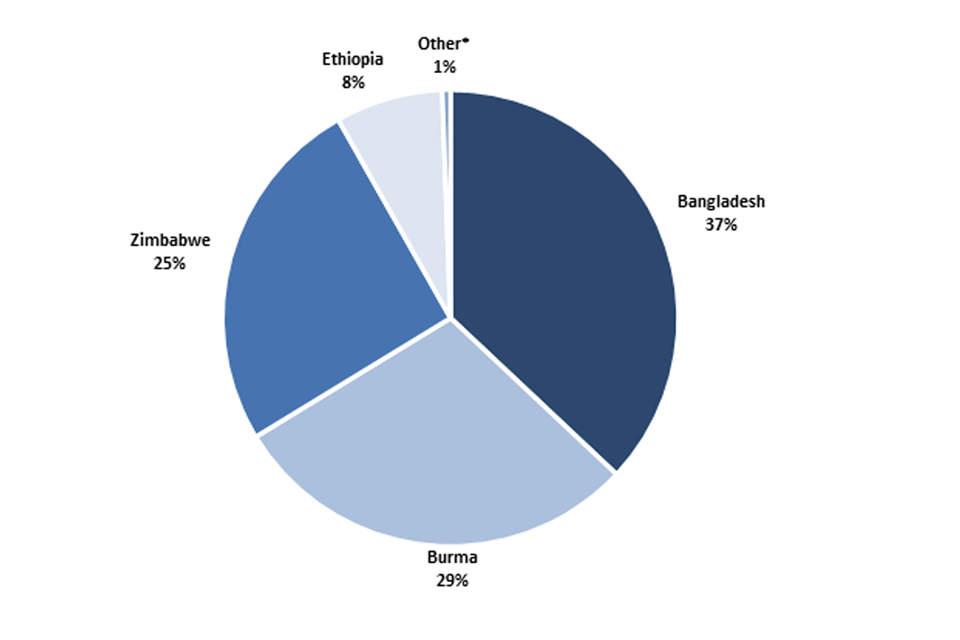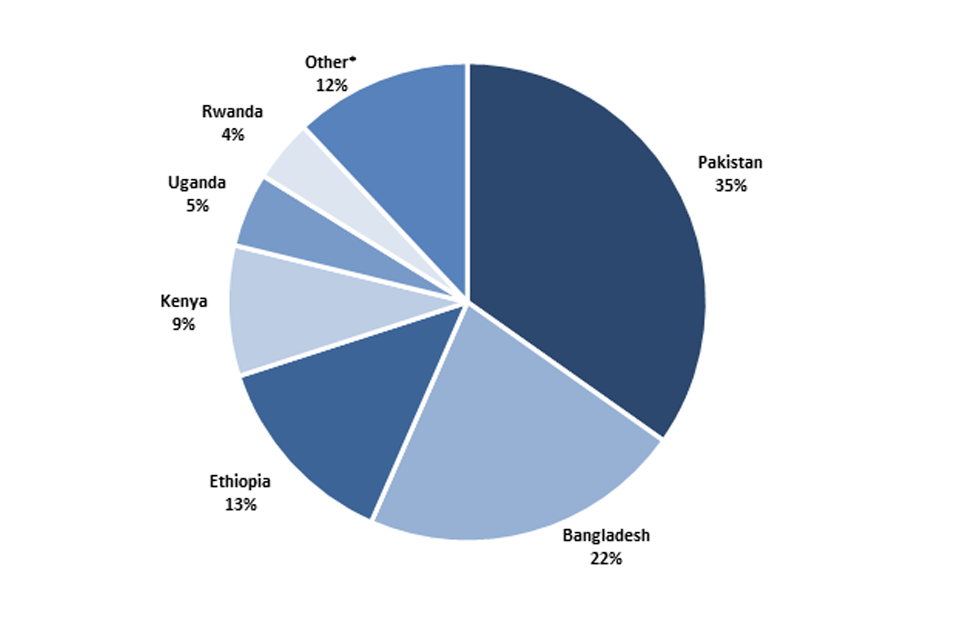DFID Annual Report and Accounts 2014 to 2015 Results: Poverty, vulnerability, nutrition and hunger
Published 16 July 2015
About 700 million fewer people lived in extreme poverty conditions in 2010 compared to 1990. Despite this fall, around 1.2 billion people live in extreme poverty. If we are to break the cycle of poverty we need to address the most pressing need of all – hunger. Today, 1 in 8 people in the world remain chronically undernourished. Hunger and malnutrition rob children of their life chances – making them much more likely to become ill, limiting brain development and stunting growth.
The Millennium Development Goals (MDGs) include 2 targets in this area. The first is to halve, by 2015, the proportion of people whose income is less than $1.25 a day. This target was met 5 years ahead of the deadline, and the global poverty rate had fallen by 2010 to less than half the rate in 1990. However, more than 1.2 billion people globally still live in extreme poverty.
The second target is to halve, by 2015, the proportion of people who suffer from hunger. The world is on track to reach the MDG hunger target by 2015, but the number of hungry people in the world remains very high. The State of Food Insecurity in the World 2015 report estimates that this number is 795 million, or around one person out of every nine. This is 216 million fewer people than in 1990-92. Extreme weather events, natural disasters, political instability and civil strife have all impeded progress – 24 African countries currently face food crises, twice as many as in 1990; around one of every five of the world’s undernourished lives in crisis environments characterized by weak governance and acute vulnerability to death and disease. Globally 162 million children are stunted and another 51 million children are severely malnourished.
1. DFID commitment
DFID has 3 specific commitments within this sector:
- help more than 6 million of the world’s poorest people to escape extreme poverty by March 2015
- stop 20 million more children going hungry by December 2015
- ensure that another 3 million people have enough food throughout the year by March 2015
2. Indicators used to measure progress
There are 3 indicators included in the DFID Results Framework to measure progress on results achieved in this sector through DFID support:
- number of people benefiting from DFID-supported cash transfer programmes
- number of children under 5 and pregnant and breastfeeding women reached through DFID’s nutrition-relevant programmes
- number of people achieving food security through DFID support
3. Results achieved
By 2014–15, DFID had achieved the following results:
- reached 9.3 million people with cash transfers
- reached 28.5 million children under 5 and pregnant and breastfeeding women through DFID’s nutrition-relevant programmes
- provided food security to 3.5 million people
For 2 of the indicators in this sector ‘number of people benefiting from DFID-supported cash transfer programmes’ and ‘number of people achieving food security through DFID support’, results have been delivered solely through DFID’s bilateral country programmes (therefore not taking account of results achieved by our multilateral partners) and, in reality, underestimates DFID’s wider impact on these areas. The cash transfers provided have helped poor and vulnerable people to meet their basic food needs and access essential services like education and healthcare. They have helped people to be more resilient in the face of shocks and crises, and to save and make small investments in productive assets and income generating activities.
The results counted under the food security indicator are from specific programmes which track dietary intake for the extreme poor. DFID also supports agriculture related programmes which seek to improve the productivity of the sector, therefore contributing to increased food security, but which do not offer specific results towards this target. This includes programmes which support: social protection; social infrastructure and services; agricultural development and services; agriculture research; rural development; small and medium-sized enterprise development and climate and environmental adaptation.
For the indicator ‘number of children under 5 and pregnant and breastfeeding women reached through DFID’s nutrition-relevant programmes’, the majority of results have been delivered through DFID’s bilateral programmes but some have been delivered through core funding to UNICEF and the World Food Programme. Our bilateral programmes in Northern Nigeria, Yemen and Ethiopia contributed most to our nutrition results. In Ethiopia, the programme aims to improve the nutritional status of women, and children under the age of five via a package of high-impact nutrition and childcare interventions: to improve exclusive breastfeeding rates, complementary feeding of young children, as well as increasing coverage of Vitamin A supplementation, deworming, and the use of zinc for the treatment of diarrhoea.
As we know nutrition specific interventions will only tackle 20% of stunting, we have a portfolio of nutrition-related programmes, which impact on nutrition outcomes but do not directly contribute to the results reported. For example, our nutrition sensitive agriculture research programme in Kenya, Malawi, Mozambique and Rwanda will enable 1.2 million farming households to grow Vitamin A enriched orange flesh sweet potato, and aims to improve dietary practices to ensure that the benefits reach women and children.
The UK also led an initiative to launch the first ever annual Global Nutrition Report at the Second International Conference on Nutrition in Rome. The report was widely welcomed and endorsed by partner governments, civil society organisations and UN agencies bringing together data on over and undernutrition. It represents a vital step forward on nutrition accountability. The report will help citizens to focus their advocacy and governments to prioritise their nutrition efforts.
4. Progress towards DFID results commitments
Results achieved up to 2014-2015 inclusive
| Indicator | Indicator type | Commitment | Male | Female | Not identified | Total |
|---|---|---|---|---|---|---|
| Number of people benefiting from DFID-supported cash transfer programmes | Peak year | 6,000,000 | 4,000,000 | 4,920,000 | 360,000 | 9,300,000 |
| Number of children under 5 and pregnant and breastfeeding women reached through DFID’s nutrition-relevant programmes* | Peak year | 20,000,000 | 7,580,000 | 11,690,000 | 9,280,000 | 28,560,000 |
| Number of people achieving food security through DFID support | Peak year | 3,000,000 | 1,660,000 | 1,860,000 | 0 | 3,520,000 |
*Results achieved through both multilateral and bilateral channels
5. Results achieved by country/department
Each of the 3 indicators in this sector has very different geographical coverage.
More than two thirds of all people benefiting from cash transfer programmes lived in Pakistan, Bangladesh or Ethiopia. There were also significant numbers living in Kenya, Uganda, Rwanda and the Occupied Palestinian Territories, as well as smaller numbers in 6 other DFID priority countries, mainly within sub-Saharan Africa.
The major contributions to the nutrition results were from bilateral programmes in Ethiopia, Nigeria, Mozambique, India and Zambia.
Food security programmes in 6 countries contribute to the results, with more than 90% of the results delivered in the top 3 contributing countries (Bangladesh, Burma and Zimbabwe).
5.1 Number of people benefiting from DFID supported cash transfer programmes (by country/department)

Number of people benefiting from DFID supported cash transfer programmes (by country/department)
5.2 Number of children under 5 and pregnant and breastfeeding women reached through DFID’s nutrition-relevant programmes (by country/department)

Number of children under 5 and pregnant and breastfeeding women reached through DFID’s nutrition relevant programmes (by country/department)
5.3 Number of people achieving food security through DFID support (by country/department)

Number of people achieving food security through DFID support (by country/department)
6. Results achieved by multilateral organisations
The following results are delivered by multilateral organisations, and fall broadly within the poverty, vulnerability, nutrition and hunger sector. These indicators were included in the multilateral section of DFID’s Results Framework. The results presented here are based on all funding that the multilateral receives, not just funding from DFID or the UK. These results are presented alongside DFID’s share of core funding to the multilateral organisations, in order to illustrate that DFID contributes a share of those results. Multilateral abbreviations and results sources can be found in the results technical notes.
| Indicator | Multilateral | Reporting period | Latest Results | DFID’s contribution as a % of total core funding[footnote 1] |
|---|---|---|---|---|
| Number of farmers given access to improved agricultural services and investment | IADB[footnote 2] | 2014 | 111,000 | 2 |
| Number of people receiving services from International Fund for Agricultural Development supported projects | IFAD | 2013 | 98,640,000 | 7 |
| Number of people trained in crop production practices/technologies | IFAD | 2013 | 3,480,000 | 7 |
| Number of malnourished children provided with special nutritional support | WFP | 2013 | 7,800,000 | 10 |
| Number of people provided with food assistance | WFP | 2013 | 80,900,000 | 10 |
| Number of school children receiving school meal and take home rations | WFP | 2013 | 18,600,000 | 10 |
| Number of women and children provided with food and nutritional support | WFP | 2013 | 67,900,000 | 10 |
-
The DFID burden share presented here are not suitable to calculate a DFID results attribution of multilateral results. The results presented in this table are achieved through all funding streams that the multilateral receive, not just limited to core funding. ↩
-
Burden share relates to the concessionary fund only. The results presented are achieved through concessionary and non-concessionary funds of the Bank. ↩
